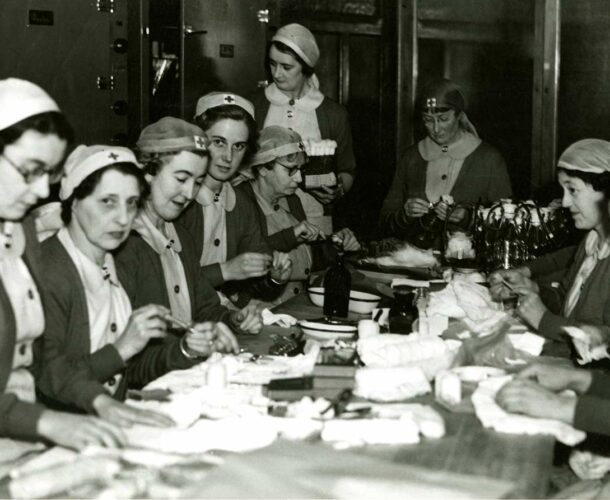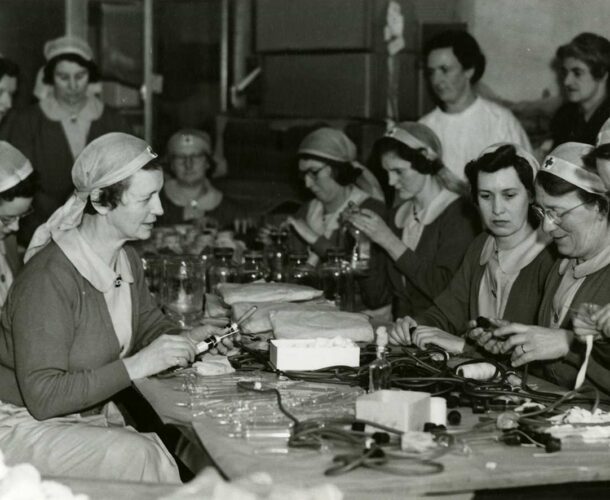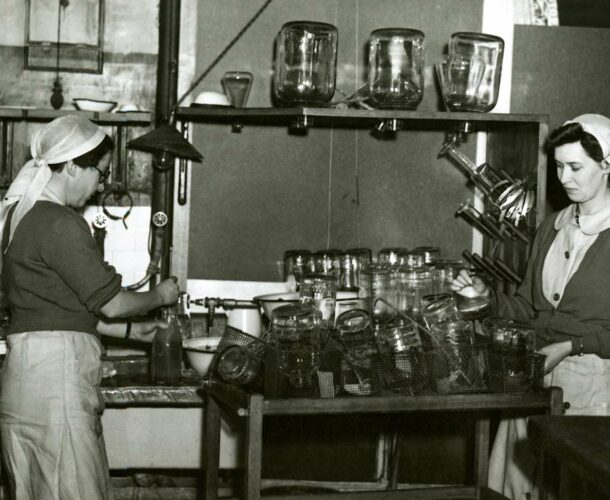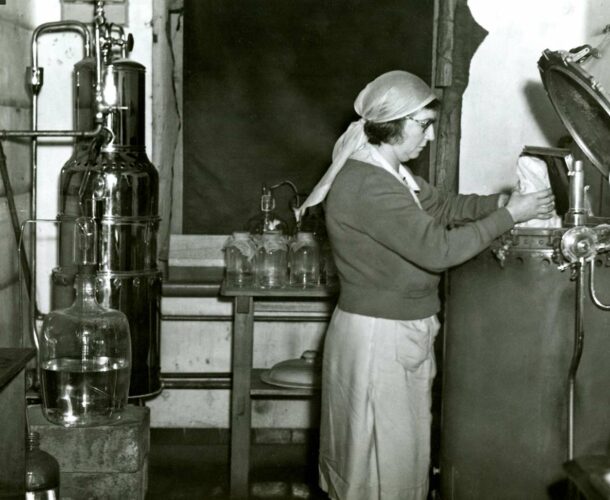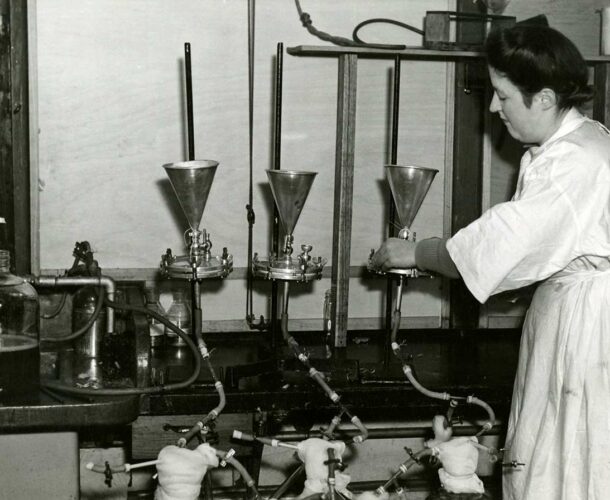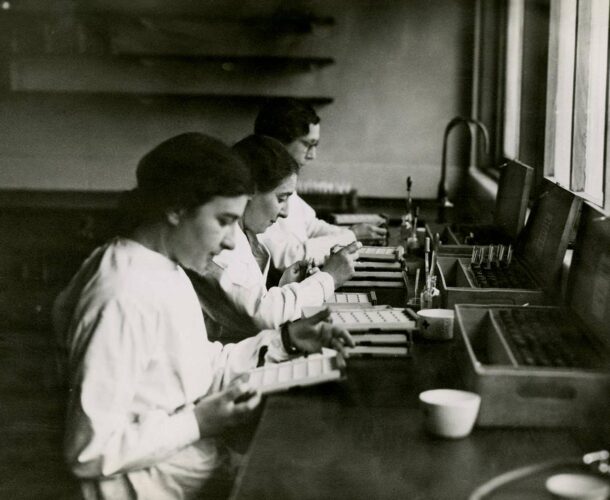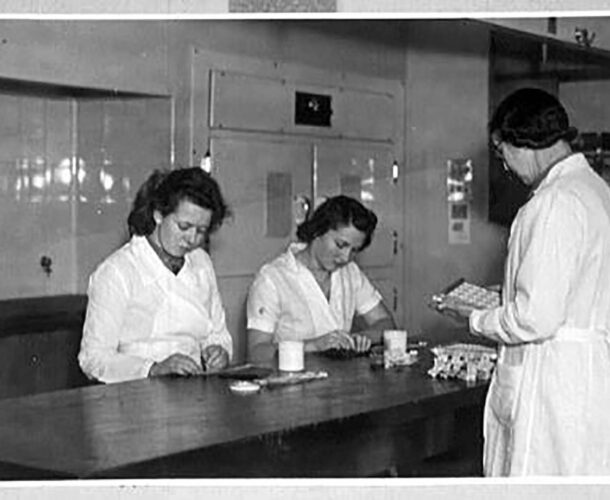Moving to a wartime footing, the institute becomes the centre of operations for the Red Cross Blood Transfusion Service (BTS), headed by Dr Lucy Bryce.
Dr Ian Wood and Miss Fannie Williams develop the techniques required to enable the establishment of a blood bank, the only one operating in Melbourne at this time.
Dr Lucy Bryce and the Blood Transfusion Service
As a student at Melbourne University, Lucy Bryce started a science degree before the ravages of the times caused her to switch to medicine. The Great War had created a need for doctors, and the future haematologist always saw the big picture. More than 20 years later her vision was instrumental in bringing blood banks and transfusion services to Australian soldiers and civilians during World War II.
The daughter of a commercial traveller, Dr Bryce held research posts at the Walter and Eliza Hall Institute before a year’s stint in 1925 at London’s Lister Institute— a magnet for people interested in the processing of blood. On her return to Melbourne she was engaged as a bacteriologist and clinical pathologist at the then Melbourne Hospital. At this time, diagnostic work was carried out at the Walter and Eliza Hall Institute’s laboratories.
Bryce’s early work in blood services
The achievements that defined her professional life began in 1929 at the instigation of the hospital superintendent Dr Eric Cooper. Together with the Victorian Division of the Red Cross Society, he established a panel of blood donors to be deployed to hospitals when required. A blood transfusion service was set up with Bryce its honorary director.
As this was before the era of stored blood and serum, her laboratory work was limited to determining donor and patient blood groups and taking care of the donors’ medical needs.
The institute braces for war
By 1938, as storm clouds gathered over Europe, the profession began moving to a war footing. Doctors began studying the blood transfusion unit in the Spanish civil war, seeing the conflict as a dress rehearsal for the greater confrontation to come. Bryce and her colleagues learned all they could about the unit’s techniques and shortcomings, and how it might be adapted to local circumstances.
Housing the Red Cross Blood Transfusion Service
In May 1939 an Emergency Blood Transfusion Service was formed. On 3 September Bryce asked the Red Cross president to activate the service, and before long almost half of the space at the Walter and Eliza Hall Institute was devoted to transfusions.
In Victoria, all new recruits had their blood type tested and recorded at the institute. By 1942 nearly a quarter of a million tests for service personnel and civilian donors had been done.
The transfusion service soon provided blood banks for the military and stockpiled civilian needs in preparation for an air attack on Australia. In 1941 an initial 220 pints of serum was processed by the Commonwealth Serum Laboratories and stored in a special refrigerator at the institute, all under the supervision of Bryce and her colleagues, who she lauded as a reliable, cheerful and trustworthy team.
Honours and recognition
During the war years Bryce was also a visiting specialist with the rank of major at the 115th Australian General Hospital at Heidelberg.
In the early 1950s she retired as honorary director of the Blood Transfusion Service. Despite ailing health after a stroke, she continued as chairman of the Divisional Blood Transfusion Service Committee for another 12 years. An honorary director of pathology at the Queen Victoria Hospital, in 1951 she was appointed Commander of the Order of the British Empire for her work in blood transfusions.
By the time of her death in 1968 she had written a history of the transfusion service and had been working on another book about her travels in Europe as a young woman. The Australian Dictionary of Biography says her words and her work, “revealed a mind that was meticulous, to a fault, while the soft voice and manner of a cultured gentlewoman concealed a surprising firmness of purpose.”




